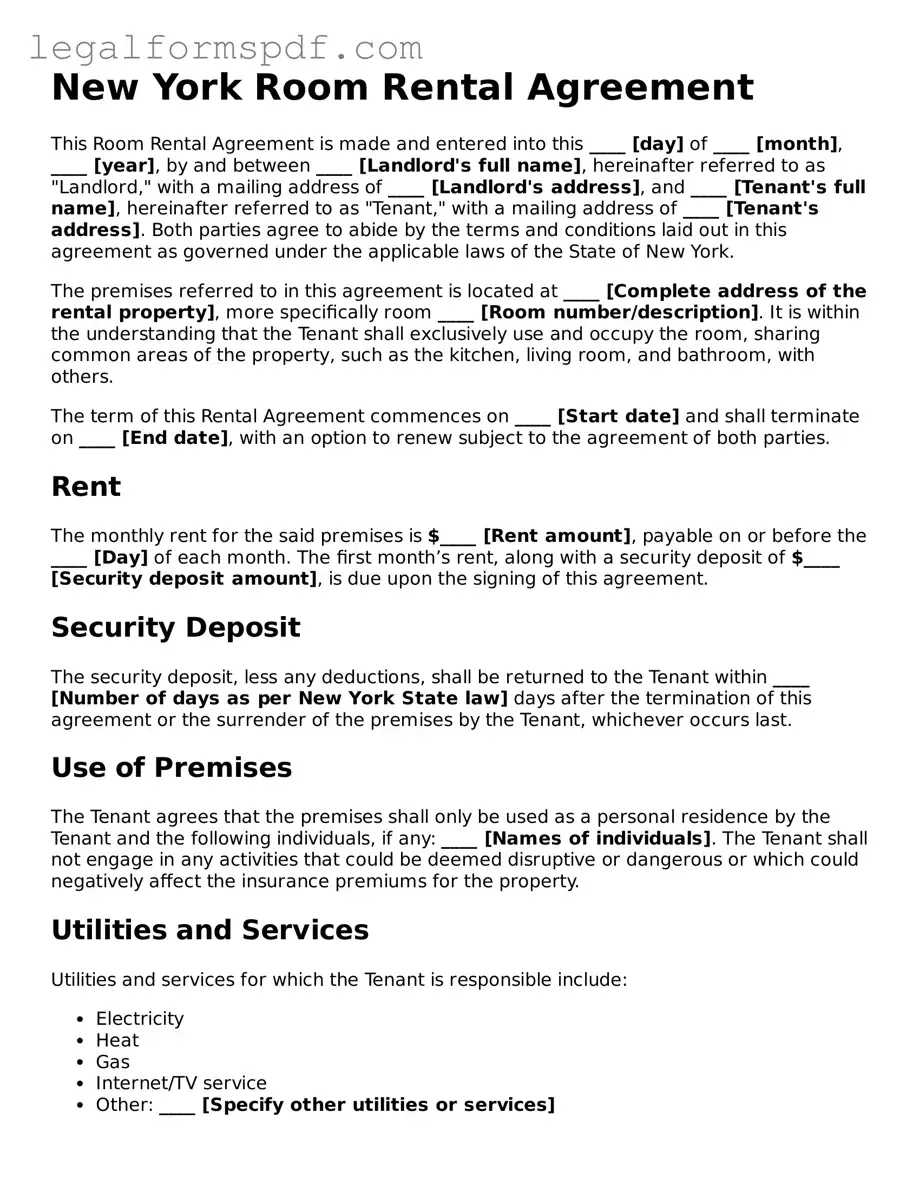New York Room Rental Agreement
This Room Rental Agreement is made and entered into this ____ [day] of ____ [month], ____ [year], by and between ____ [Landlord's full name], hereinafter referred to as "Landlord," with a mailing address of ____ [Landlord's address], and ____ [Tenant's full name], hereinafter referred to as "Tenant," with a mailing address of ____ [Tenant's address]. Both parties agree to abide by the terms and conditions laid out in this agreement as governed under the applicable laws of the State of New York.
The premises referred to in this agreement is located at ____ [Complete address of the rental property], more specifically room ____ [Room number/description]. It is within the understanding that the Tenant shall exclusively use and occupy the room, sharing common areas of the property, such as the kitchen, living room, and bathroom, with others.
The term of this Rental Agreement commences on ____ [Start date] and shall terminate on ____ [End date], with an option to renew subject to the agreement of both parties.
Rent
The monthly rent for the said premises is $____ [Rent amount], payable on or before the ____ [Day] of each month. The first month’s rent, along with a security deposit of $____ [Security deposit amount], is due upon the signing of this agreement.
Security Deposit
The security deposit, less any deductions, shall be returned to the Tenant within ____ [Number of days as per New York State law] days after the termination of this agreement or the surrender of the premises by the Tenant, whichever occurs last.
Use of Premises
The Tenant agrees that the premises shall only be used as a personal residence by the Tenant and the following individuals, if any: ____ [Names of individuals]. The Tenant shall not engage in any activities that could be deemed disruptive or dangerous or which could negatively affect the insurance premiums for the property.
Utilities and Services
Utilities and services for which the Tenant is responsible include:
- Electricity
- Heat
- Gas
- Internet/TV service
- Other: ____ [Specify other utilities or services]
Maintenance and Repairs
The Tenant agrees to keep the rented room and common areas in clean and sanitary condition. The Tenant is responsible for any damages caused by their negligence or misuse of the property. The Landlord is required to maintain the structure of the building and ensure that heating, plumbing, and electrical systems are in working order.
Rules and Regulations
The Tenant agrees to comply with all applicable building, housing, and health codes and to adhere to rules established by the Landlord regarding the use of common areas and behavior within the property. Specific rules and regulations attached to this agreement include:
- ____ [Rule/regulation 1]
- ____ [Rule/regulation 2]
- ____ [Other rules and regulations]
Governing Law
This Agreement shall be governed, construed, and interpreted by, through, and under the Laws of the State of New York.
IN WITNESS WHEREOF, the parties have executed this agreement as of the date first written above.
Landlord Signature: ___________________________ Date: ________
Tenant Signature: ___________________________ Date: ________
